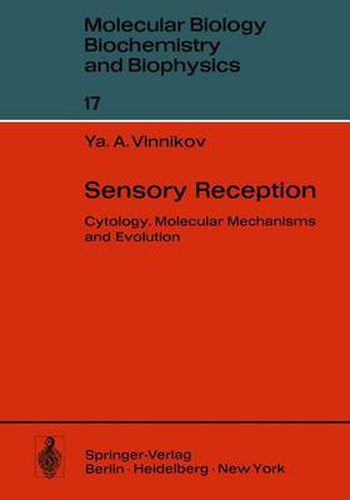Readings Newsletter
Become a Readings Member to make your shopping experience even easier.
Sign in or sign up for free!
You’re not far away from qualifying for FREE standard shipping within Australia
You’ve qualified for FREE standard shipping within Australia
The cart is loading…






This title is printed to order. This book may have been self-published. If so, we cannot guarantee the quality of the content. In the main most books will have gone through the editing process however some may not. We therefore suggest that you be aware of this before ordering this book. If in doubt check either the author or publisher’s details as we are unable to accept any returns unless they are faulty. Please contact us if you have any questions.
This book presents a distillation of many years of investigation by the author and his associates on the problem of sensory reception. Both our own data and data from the scientific literature on the electron microscopy, cytochemistry, biochemistry and electrophysiology of the organs of vision, taste, smell, hearing and gravitation, are presented to show that the evolution of the sense organs of all animals on our planet is based on a receptor cell equipped with a motile antenna, a biological recorder of information concerning certain types of energy reaching the animal from the environment. The conversion or encoding of this energy into information is effected with the aid of special protein molecules positioned in the plasma membrane of the antennae. The action of the unit of energy of a stimulus on such a specific protein molecule causes a change of shape, and this is the basis of the trigger mechanism of reception, leading to the stimulation of the receptor cell and the transmission of the information encoded in this cell in the form of nerve impulses to the central nervous system. The present monograph summarizes over 30 years of working experience by the author and his associates in the field of evolution of sense organs. Material is used here from his earlier monographs: The Retina of the Eye Vertebrates, 1947, The Morphology of the Organ of Smell, 1957, The Organ of Corti: Its Histophy siology and Histochemistry, 1964, written jointly with L. K.
$9.00 standard shipping within Australia
FREE standard shipping within Australia for orders over $100.00
Express & International shipping calculated at checkout
This title is printed to order. This book may have been self-published. If so, we cannot guarantee the quality of the content. In the main most books will have gone through the editing process however some may not. We therefore suggest that you be aware of this before ordering this book. If in doubt check either the author or publisher’s details as we are unable to accept any returns unless they are faulty. Please contact us if you have any questions.
This book presents a distillation of many years of investigation by the author and his associates on the problem of sensory reception. Both our own data and data from the scientific literature on the electron microscopy, cytochemistry, biochemistry and electrophysiology of the organs of vision, taste, smell, hearing and gravitation, are presented to show that the evolution of the sense organs of all animals on our planet is based on a receptor cell equipped with a motile antenna, a biological recorder of information concerning certain types of energy reaching the animal from the environment. The conversion or encoding of this energy into information is effected with the aid of special protein molecules positioned in the plasma membrane of the antennae. The action of the unit of energy of a stimulus on such a specific protein molecule causes a change of shape, and this is the basis of the trigger mechanism of reception, leading to the stimulation of the receptor cell and the transmission of the information encoded in this cell in the form of nerve impulses to the central nervous system. The present monograph summarizes over 30 years of working experience by the author and his associates in the field of evolution of sense organs. Material is used here from his earlier monographs: The Retina of the Eye Vertebrates, 1947, The Morphology of the Organ of Smell, 1957, The Organ of Corti: Its Histophy siology and Histochemistry, 1964, written jointly with L. K.